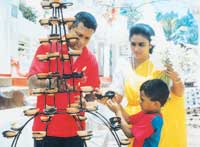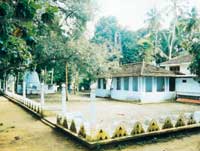|
Gaveshaka
looks at the place of the temple in the village
Just as much as the paddy field and the tank were of vital importance to the peasants, so was the temple. All the villagers being Buddhists, every village had a temple. It was a familiar sight to see the ‘dagoba’ and the temple surrounded by paddy fields. At least one monk was resident in the village temple. The villagers looked after him. The monk would go on ‘pindapatha’ at least once a day, usually in the morning, for his meals. Taking his ‘pattaraya’, the alms bowl, he would start at the crack of dawn for the ‘heel dane’ or morning alms. He would take a different route every day visiting a few houses each morning thereby giving a chance for everyone in the village to offer alms.
The ‘daval dane’ or the mid-day alms would generally be brought to the temple and after offering a portion of the food to the Buddha in the form of ‘buddha pooja’, the monks would be served the alms. The ‘dayakas’ who bring the alms would observe ‘pan sil’ - the five precepts- and the monk would deliver a short sermon reminding the devotees of how they would acquire merit by giving alms. The devotees would reverently worship him and then serve the alms to the bowl. Usually the monk would accept only a single serving, so the devotees would make sure that sufficient food is served. The Buddhist monk gave leadership in the village. The peasant turned to him for advice. The monk performed several vital functions in the daily life of the villagers. Chanting of ‘pirith’ offering protection to the individuals, participation in activities in the village and offering his blessings, partaking of the ‘dana’, alms offered by the ‘dayakas’ were all part of the monk’s routine. Within the precincts of the temple were several places of worship. The ‘budu ge’, as the name suggests, had images of the Buddha in seated and reclining positions. The ‘buddha pooja’ was offered in the image house. The ‘vehera’ or ‘dagoba’ was built to an accepted size and shape and had relics enshrined. The ‘bodhi’ symbolised the tree under which Prince Siddartha attained Enlightenment. Apart from these places of worship, a temple consisted of the ‘avasaya’, where the monks stayed, a ‘bana maduva’, the preaching hall where the villagers gathered on a Poya day to observe ‘sil’ and listen to ‘bana’ sermons, and a ‘gantara’, a bell fixed on to a tall tower. The bell was rung as a signal for the villagers to meet at the temple. It was generally a call from the monk to discuss urgent or important issue affecting him or the village. If there are signs that the alms were getting delayed, the ‘kepakaru’ would ring the bell and indicate that time is up to bring the alms. The ‘bana maduva’ was a simple half-wall structure with short gates on all four side. The temple
was considered a sacred place and the villagers treated it with
respect and dignity. They would see to it that the youngsters behaved
themselves in the temple premises and made sure that they took part
in religious activities with decorum. The ‘bana maduva’ was the meeting place to discuss community activities. The needs of the villagers were discussed there. Activities beneficial to the village were planned. The monk always presided over the discussions and gave advice. In case a road was to be cut, everyone would first gather at the temple and start work after paying obeisance to the monk. Thus the temple was the focal point in the village. Rarely did the villagers act against the wishes of the monk. Being the most learned person in the village, the monk had to read the first letters to the kids. Having looked at ‘nekath’ according to the child’s horoscope, on an auspicious day, at an auspicious time, the child would be brought to the temple for the ‘akuru kiyaveema’. The monk read the first letters getting the child to repeat after him and also helped in writing the first letters either on the sand in the temple premises or on the ‘gal lella’ - the slate. It was customary
for parents to get the monk to chant ‘pirith’ to bless
their daughter expecting a baby. They would bring the daughter to
the temple, offer a sheaf of betel to the monk and invite him to
chant ‘pirith’. In the same manner, if the monk hears
that one of his ‘dayakas’ was not well, he would visit
his home, chant ‘seth pirith’ and bless him. |
||||
Copyright © 2001 Wijeya Newspapers
Ltd. All rights reserved. |

